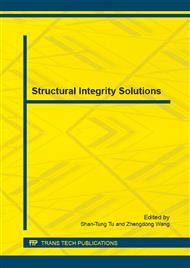[1]
Gan Guo-gong. Plastic Pipes Reinforced by Cross Helically Wound Steel Wires. CN2550090Y. (2002). (in Chinese).
Google Scholar
[2]
Zheng Jinyang, Li Xiang, XU Ping, et al. Analyses on the short-term mechanical properties of Plastic Pipe Reinforced by Cross Helically Wound Steel Wires. ASME Journal of the Pressure Vessel Technology, 131(2009) 031401-1-031401-10.
DOI: 10.1115/1.3066826
Google Scholar
[3]
Zheng Jinyang, Lu Yubin, Li Xiang. Experimental Investigation on Mechanical Properties of Plastic Pipes Reinforced by Cross Helically Wound Steel Wires. ASME Journal of Pressure Vessel and Technology, 130 (2008) 1-7.
DOI: 10.1115/1.2892028
Google Scholar
[4]
Chen Jiawei, Ye Zhiming, Chen Lingli. Analysis on finite element aseismatic of buried pipeline. Water Technology. 2(2008) 21-24. (in Chinese).
Google Scholar
[5]
Spangler. M.G. Underground Conduits-An Appraisal of Modern Research. Trans. of ASCE, (1948).
Google Scholar
[6]
Wang Wei-sheng. the Status Quo of External Load Calculation of China's Buried Concrete Pipe and Comparative Analysis. CONCRETE AND CEMENT PRODUCTS, 1(1994)26-31. (in Chinese).
Google Scholar
[7]
Newmark N M, Hall W J. Pipeline design to resist large fault displacement. Proceedings of US NationalConference on Earthquake Engineering, Ann Arbor, (1975) 416-425.
Google Scholar
[8]
Liang Jian-wen. The Seismic Response and Dynamic Stability of Underground Pipelines. (1991) Tianjin: Tianjin University, doctoral thesis. (in Chinese).
Google Scholar
[9]
Shiro Takada, Liang Jian-Wen, Li Teng-yan. Shell-model response of buried pipelines to large fault movements. Journal of Structural Engineering. 44(1998) 1637-1646.
Google Scholar
[10]
Wu Jia-long. Elastic Mechanics. Beijing: Higher Education Press, (2001). (in Chinese).
Google Scholar
[11]
Li Jing-pei, Ding Shi-jun, Influence of Additional Load Caused by Adjacent Buildings on Underground Pipeline. Journal of Tongji University(Natural Science), 32(2004)1553-1557. (in Chinese).
Google Scholar
[12]
Li Da-yong, Zhang Tu-qiao, Gong Xiao-nan. Analysis of the Displacements of Buried Pipelines Caused by Deep Excavations. INDUSTRIAL CONSTRUCTION. 29 (1999)36-41. (in Chinese).
Google Scholar
[13]
DUAN Shao-wei, SHEN Pu-sheng. Analysis of Nearby Pipeline Damage Induced by Deep Excavation. Engineering Mechanics, 22(2005): 79-83. (in Chinese).
Google Scholar
[14]
Yang Jun-tao. Research on Longitudinal Mechanical Characteristics of Pipelines Buried in Soft Soil under Vertical Loads. (2006), Hangzhou: Zhejiang University, Master Degree's Dissertations. (in Chinese).
Google Scholar
[15]
Lin Xiu-feng. Strength Analysis and Optimization of Plastic Pipes Reinforced by Cross Helically Wound Steel Wires. (2008), Hangzhou: Zhejiang University, Master Degree's Dissertations. (in Chinese).
Google Scholar
[16]
X. Sun. Polyolefine pipelines. Chemical Industry Press, Beijing, (2002). (in Chinese).
Google Scholar


